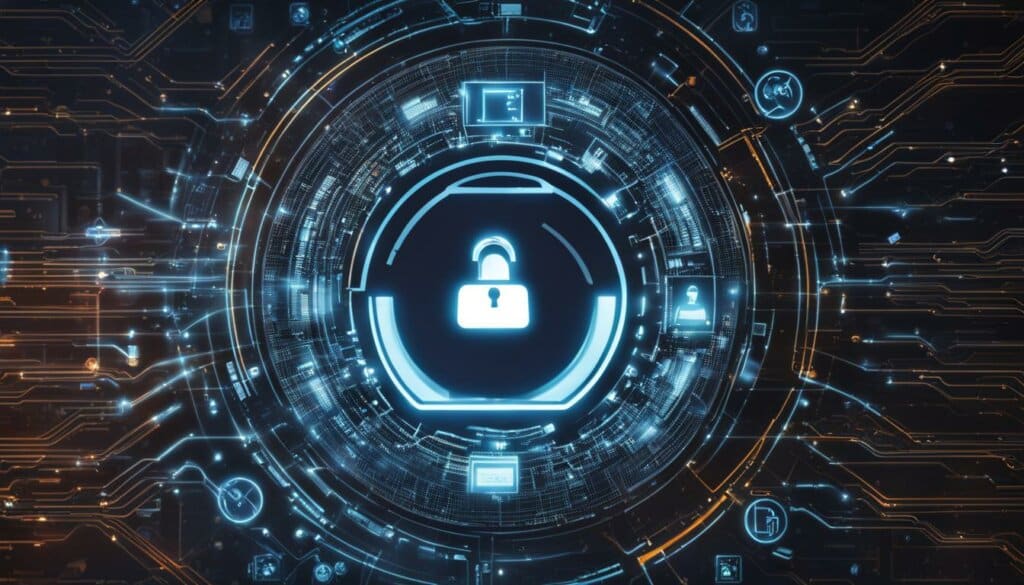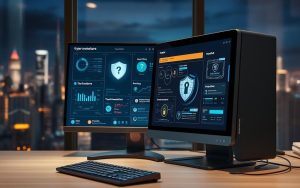Table of Contents
Cybersecurity against espionage is of paramount importance in today’s digital landscape. As businesses and government entities increasingly rely on technology to store and transmit sensitive data, the need for robust data protection and information security measures has never been greater. In this article, we will explore the world of cyber espionage, its implications, and how you can safeguard your data from intruders.
What is Cyber Espionage?
Cyber espionage, also known as cyber spying, is a type of cyber attack carried out by malicious hackers against businesses and government entities. The goal of cyber espionage is to gain unauthorized access to sensitive information and intelligence for competitive advantage. It is often a complex and expensive attack to carry out, as the attackers aim to remain undetected in the IT environment for long periods of time.
These malicious hackers employ various tactics to achieve their objectives, including exploiting vulnerabilities in websites or browsers, using spear phishing emails to escalate network privileges, conducting supply chain attacks against the primary target’s partners, deploying malware, Trojans, and worms, and infecting updates for commonly used third-party software applications.
Cyber espionage attacks are not crimes of opportunity but are carefully planned and executed, with an emphasis on covert action, the access or theft of sensitive information or intellectual property, and a specific target and motive. Perpetrators of cyber espionage attacks go to great lengths to conceal their actions, motives, and identities. They target highly valuable and closely guarded information, such as proprietary formulas, secret projects, internal plans, and market intelligence.
Tactics Used in Cyber Espionage
Cyber espionage tactics can vary and include:
- Exploiting vulnerabilities in websites or browsers
- Using spear phishing emails to escalate network privileges
- Conducting supply chain attacks against the primary target’s partners
- Deploying malware, Trojans, and worms
- Infecting updates for commonly used third-party software applications
These tactics are designed to gain unauthorized access to sensitive information and intelligence, allowing the attackers to remain hidden and gather valuable data over long periods of time.
Difference Between Cyber Espionage and Cyberwarfare
While cyber espionage and cyberwarfare are related concepts, they have distinct differences. Cyber espionage focuses on gathering intelligence and remaining hidden for as long as possible, while cyberwarfare aims to disrupt the activities of a nation-state. Cyber espionage can be seen as a precursor or preparation for cyberwarfare, as the gathered intelligence can be used to launch disruptive attacks.
Cyber espionage: The primary goal of cyber espionage is to gather sensitive information and intelligence for competitive advantage. Malicious hackers target businesses and government entities to gain unauthorized access to data and remain undetected in the IT environment for extended periods of time. Cyber espionage attacks are often complex and expensive to carry out, as the attackers aim to remain hidden and extract valuable information without being detected.
Cyberwarfare: On the other hand, cyberwarfare focuses on using cyber attacks to disrupt and destabilize critical computer systems, often as a part of nation-state conflicts. It involves attacks carried out by nation-states against other countries’ critical infrastructure, such as power grids, communication networks, and military systems. The goal of cyberwarfare is to cause significant harm and damage to the targeted nation’s activities, potentially leading to political, economic, or military advantages.
Key Differences:
- Cyber espionage aims to gather intelligence, while cyberwarfare aims to disrupt and destabilize.
- Cyber espionage is focused on remaining hidden and extracting valuable information, while cyberwarfare involves carrying out attacks on critical computer systems.
- Cyber espionage can be used as a preparation for cyberwarfare if the gathered intelligence is used to launch disruptive attacks.
Understanding the differences between cyber espionage and cyberwarfare is important for organizations and governments to develop effective strategies for protecting against both types of threats. While cyber espionage is primarily about defending against unauthorized access to sensitive information, cyberwarfare requires measures to secure critical infrastructure and systems from disruptive attacks.
| Aspect | Cyber Espionage | Cyberwarfare |
|---|---|---|
| Objective | Gather intelligence and competitive advantage | Disrupt and destabilize critical computer systems |
| Main Targets | Businesses and government entities | Critical infrastructure of nations |
| Focus | Remaining hidden and extracting valuable information | Carrying out attacks on critical computer systems |
| Relation | Can be used as preparation for cyberwarfare | Can be a result of cyber espionage |
Targets of Cyber Espionage
Cyber espionage poses a significant threat to both government entities and large corporations. These entities are attractive targets due to the sensitive information they possess, which can be exploited for political, economic, or competitive advantage. Governments and corporations alike must remain vigilant and take proactive measures to protect their data from malicious actors.
Government entities are prime targets for cyber espionage due to the wealth of classified information they hold. State-sponsored attacks often seek to gain access to government secrets, intelligence, and diplomatic communications. Large corporations, especially those in industries such as defense, technology, finance, and manufacturing, are also attractive targets. These companies possess valuable proprietary information, trade secrets, and customer data that can be leveraged for economic gain or used to gain a competitive edge.
While any government or large corporation can become a target, there are certain countries that are particularly vulnerable to cyber espionage. According to the U.S. Department of Homeland Security, countries such as the United States, Canada, Brazil, and Germany are among the best prepared to handle cyber attacks. However, the United States, South Korea, Japan, Russia, China, and the United Kingdom are commonly targeted due to their political influence, advanced technological infrastructure, and economic strength.

| Government Entities | Large Corporations |
|---|---|
| Classified information | Proprietary information |
| Diplomatic communications | Trade secrets |
| Intelligence | Customer data |
Tactics Used in Cyber Espionage
Cyber espionage is carried out using various tactics that exploit vulnerabilities in systems and target individuals to gain unauthorized access to sensitive information. Understanding these tactics is essential to effectively protect against cyber espionage attacks. Some of the common tactics used in cyber espionage include:
Spear Phishing
Spear phishing is a highly targeted form of phishing where attackers send tailored emails to specific individuals or organizations. These emails appear legitimate and often contain personalized information or references that trick the recipient into clicking on malicious links or providing sensitive information. Spear phishing attacks are successful because they exploit human vulnerabilities and rely on social engineering techniques.
Malware
Malware is frequently used in cyber espionage attacks to gain control over targeted systems and steal sensitive data. Attackers deploy various types of malware, including Trojans, worms, and spyware, which are often disguised as legitimate files or programs. Once the malware infects a system, it can provide the attackers with remote access, allowing them to monitor activities, extract data, and escalate privileges within the compromised network.
Exploiting Software Vulnerabilities
Cyber espionage attackers often exploit vulnerabilities in software applications, operating systems, or network protocols to gain unauthorized access. They search for weaknesses that can be exploited to bypass security measures or gain control over systems. These vulnerabilities can include unpatched software, misconfigurations, or even zero-day vulnerabilities that are unknown to the software vendor.
By leveraging these tactics, cyber espionage attackers can infiltrate targeted systems, gather sensitive information, and remain undetected for extended periods of time. It is crucial for organizations to be aware of these tactics and implement robust security measures to protect their data.
| Vulnerability | Description |
|---|---|
| Unpatched Software | Exploiting known vulnerabilities in software that has not been updated with the latest security patches. |
| Social Engineering | Manipulating individuals into revealing sensitive information or performing actions that compromise security. |
| Weak Passwords | Gaining unauthorized access to systems by exploiting weak or easily guessable passwords. |
| Phishing Attacks | Tricking individuals into providing sensitive information, such as login credentials, through deceptive emails or websites. |
| Third-Party Vulnerabilities | Targeting vulnerabilities in third-party software or services that are integrated with the organization’s systems. |
Preventing Cyber Espionage and Protecting Data
Preventing cyber espionage and protecting sensitive data is of utmost importance for organizations in today’s digital landscape. By implementing strong security policies and following best practices, businesses can significantly reduce the risk of falling victim to cyber espionage attacks and ensure the safety of their valuable information.
One crucial step in preventing cyber espionage is to identify and understand the tactics used by malicious actors. Organizations should stay vigilant and regularly monitor their systems for any unexpected behaviors or anomalies that could indicate a potential attack. This can be done by utilizing advanced threat detection tools and implementing network monitoring solutions.
It is also essential for organizations to develop and enforce robust security policies, including access control measures and data protection protocols. By establishing strict access controls, organizations can limit the potential for unauthorized access to sensitive information. Additionally, regular patching of known vulnerabilities and vetting the security of third-party software systems can help safeguard against cyber espionage.
| Preventive Measures | Description |
|---|---|
| Create a Cybersecurity Policy | Develop a comprehensive cybersecurity policy that outlines the organization’s security standards and protocols. This policy should provide guidelines for employees on how to protect sensitive data and respond to potential security incidents. |
| Establish an Incident Response Plan | Develop an incident response plan that outlines the steps to be taken in the event of a cyber espionage attack. This plan should include procedures for identifying, containing, and mitigating the impact of the attack. |
| Educate Employees about Security Policies | Regularly train employees on cybersecurity best practices, such as identifying phishing emails, using strong passwords, and recognizing potential security threats. This education should be an ongoing effort to ensure employees remain vigilant and informed. |
| Implement a Password Management Policy | Enforce a strong password management policy that requires employees to use complex passwords and regularly update them. Implementing multi-factor authentication can further enhance the security of sensitive accounts. |
| Monitor Data Stored on Mobile Devices | Implement strict security measures for mobile devices, such as encryption, remote wipe capabilities, and secure app installations. Regularly monitor and update mobile devices to ensure they are protected against emerging threats. |
By implementing these preventive measures and continually adapting security practices to evolving threats, organizations can significantly enhance their defenses against cyber espionage and protect their valuable data from falling into the wrong hands.

Examples of Cyber Espionage Attacks
In recent years, there have been several high-profile cyber espionage attacks that have highlighted the growing threat posed by state-sponsored hackers and sophisticated cybercriminal groups. These attacks have demonstrated the ability of attackers to infiltrate even well-protected organizations and government agencies, compromising sensitive information and causing significant damage. One notable example of a cyber espionage attack is the SolarWinds attack, which occurred in 2020.

“The SolarWinds attack was a highly sophisticated cyber espionage operation that targeted numerous U.S. organizations and government agencies. The attack utilized a backdoor in the SolarWinds Orion IT management software, which allowed the attackers to gain unauthorized access to networks and carry out their espionage activities undetected.”
The SolarWinds attack was attributed to a Russian state-sponsored hacking group known as APT29 or Cozy Bear. This group is known for its advanced cyber capabilities and has been involved in previous cyber espionage attacks targeting various countries and industries. In addition to the SolarWinds attack, Cozy Bear has targeted organizations such as the Norwegian Police Security Service and has attempted to hack into Dutch ministries.
Another significant example of a cyber espionage attack is the state-sponsored hack of Sony Pictures by North Korea in 2014. This attack was carried out as retaliation for the release of a movie that depicted the fictional assassination of North Korean leader Kim Jong-un. The attack resulted in the theft and public release of sensitive company data, including employee emails and unreleased films.
| Example | Year | Perpetrators |
|---|---|---|
| SolarWinds attack | 2020 | Affiliated with APT29 or Cozy Bear, a Russian state-sponsored hacking group |
| Sony Pictures hack | 2014 | North Korean state-sponsored hackers |
Key Factors of Cyber Espionage
When it comes to cyber espionage, there are key factors that distinguish it from other cyber threats. Cyber espionage is characterized by its emphasis on covert action, the access or theft of sensitive information, and a specific target and motive. Perpetrators of cyber espionage attacks go to great lengths to conceal their actions, motives, and identities. They target highly valuable and closely guarded information, such as proprietary formulas, secret projects, internal plans, and market intelligence.
The covert nature of cyber espionage makes it a challenging threat to detect and prevent. Attackers utilize sophisticated tactics to remain undetected, often infiltrating networks for extended periods of time. By covering their tracks and blending in with normal network activity, they can maintain access and continue to gather intelligence without raising suspicion.
Another key factor of cyber espionage is the theft of sensitive information. Attackers specifically target information that can provide them with a competitive advantage, whether it’s stealing trade secrets, intellectual property, or confidential customer data. The stolen information can be used for various purposes, such as gaining a market advantage, selling the data on the dark web, or even leveraging it for political or strategic purposes.
“Cyber espionage attacks are not crimes of opportunity but are carefully planned and executed.”
Overall, cyber espionage attacks are highly targeted and strategic. They involve meticulous planning and execution, with attackers utilizing advanced techniques and tools to breach networks and gain unauthorized access to sensitive information. To defend against cyber espionage, organizations need to implement robust security measures, including regular vulnerability assessments, network monitoring, employee awareness training, and incident response plans.
| Key Factors of Cyber Espionage |
|---|
| Covert Action |
| Theft of Sensitive Information |
| Specific Target and Motive |
Cyber Espionage vs. Cyber Warfare
Cyber espionage and cyber warfare are two distinct but interconnected concepts in the world of cybersecurity. While cyber espionage focuses on gathering intelligence and gaining a competitive advantage, cyber warfare aims to disrupt and destabilize critical computer systems. These two forms of cyber attacks involve different motives and tactics, but they can overlap in certain situations, leading to a transition from espionage to warfare.
Cyber espionage is primarily driven by the desire to gather classified information, trade secrets, or sensitive data. The aim is to remain undetected within the targeted organization’s network for as long as possible, enabling the attacker to extract valuable information without raising suspicion. This stolen intelligence can then be used for various purposes, such as gaining a competitive edge in business or influencing geopolitical situations.
In contrast, cyber warfare focuses on using cyber attacks to disrupt and inflict damage on a nation-state’s critical infrastructure. These attacks are often executed by one country against another and are aimed at causing chaos, systemic failures, or even physical harm. Cyber warfare can involve disabling power grids, disrupting financial systems, or compromising defense networks, with the intention of destabilizing the targeted nation and gaining a strategic advantage.
Key Differences:
- Motive: Cyber espionage is driven by the desire to gain intelligence and competitive advantage, while cyber warfare seeks to disrupt and destabilize critical systems.
- Targets: Cyber espionage usually targets specific organizations or industries to gain access to sensitive information, while cyber warfare targets critical infrastructure, such as power grids or defense networks, to inflict damage on a nation-state.
- Execution: Cyber espionage focuses on covert operations, staying hidden within the targeted network, while cyber warfare often involves more overt attacks that aim to disrupt or disable systems.
- Consequences: The consequences of cyber espionage are primarily focused on the loss of sensitive information and potential economic harm. In contrast, cyber warfare can have far-reaching consequences, including physical disruptions, geopolitical tensions, and the potential for military escalation.
While cyber espionage and cyber warfare have distinct differences, it is important to recognize that they are not mutually exclusive. In some cases, cyber espionage operations can serve as a precursor to cyber warfare, with the gathered intelligence being used to plan and execute disruptive attacks. Therefore, organizations must remain vigilant and employ robust cybersecurity measures to protect against the potential risks posed by both cyber espionage and cyber warfare.
| Cyber Espionage | Cyber Warfare |
|---|---|
| Focuses on gathering intelligence and competitive advantage | Aims to disrupt and destabilize critical systems |
| Targets specific organizations or industries | Targets critical infrastructure |
| Covert operations, staying hidden within the targeted network | Overt attacks that aim to disrupt or disable systems |
| Consequences primarily focus on loss of sensitive information and potential economic harm | Far-reaching consequences, including physical disruptions, geopolitical tensions, and potential military escalation |
Conclusion
To protect against cyber espionage and safeguard sensitive data, organizations must implement effective counterintelligence measures. By following best practices in cybersecurity, organizations can minimize the risk of cyber espionage attacks and ensure the integrity of their data.
Staying vigilant is key. Continuous monitoring of systems for unexpected behaviors can help detect and mitigate potential threats. It is also important to educate employees about security policies and promote a culture of security awareness throughout the organization.
Collaborating with cybersecurity professionals and utilizing advanced threat protection solutions can provide added layers of defense against cyber espionage. These measures can help organizations proactively identify and respond to potential threats, ensuring the security and confidentiality of their data.
By prioritizing cyber espionage protection and implementing robust counterintelligence measures, organizations can effectively safeguard their data and stay one step ahead of malicious actors in the ever-evolving landscape of cyber threats.
FAQ
What is cyber espionage?
Cyber espionage, also known as cyber spying, is a type of cyber attack where malicious hackers target businesses and government entities to gain advantages over rival companies or governments.
How is cyber espionage different from cyberwarfare?
Cyber espionage focuses on gathering intelligence and remaining hidden, while cyberwarfare aims to disrupt the activities of a nation-state.
Who are the targets of cyber espionage?
Any government or large corporation can be a target of cyber espionage.
What tactics are used in cyber espionage?
Cyber espionage tactics include exploiting vulnerabilities, spear phishing, supply chain attacks, malware deployment, and infecting software updates.
How can organizations prevent cyber espionage and protect their data?
Organizations can prevent cyber espionage by identifying attack techniques, monitoring systems, enacting data security policies, patching vulnerabilities, vetting third-party software, and implementing security measures for mobile devices.
Can you provide examples of cyber espionage attacks?
Examples of cyber espionage attacks include the SolarWinds attack attributed to the Russian hacking group APT29, as well as the state-sponsored hack of Sony Pictures by North Korea.
What are the key factors of cyber espionage?
Cyber espionage attacks are characterized by covert action, theft of sensitive information, and a specific target and motive.
What is the difference between cyber espionage and cyber warfare?
Cyber espionage focuses on intelligence gathering, while cyber warfare aims to disrupt critical computer systems.
How can organizations protect against cyber espionage?
Organizations should implement effective counterintelligence measures, follow cybersecurity best practices, monitor systems, educate employees, and collaborate with cybersecurity professionals.
Source Links
- https://www.techtarget.com/searchsecurity/definition/cyber-espionage
- https://www.varonis.com/blog/what-is-cyber-espionage
- https://www.fortinet.com/resources/cyberglossary/cyber-espionage









